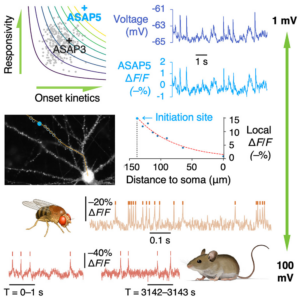
The graphical abstract from this study. Image copyright Elsevier.
A fast and responsive voltage indicator with enhanced sensitivity for unitary synaptic events
Published in Neuron.
Authors
Yukun A Hao, Sungmoo Lee, Richard H Roth, Silvia Natale, Laura Gomez, Jiannis Taxidis, Philipp S O’Neill, Vincent Villette, Jonathan Bradley, Zeguan Wang, Dongyun Jiang, Guofeng Zhang, Mengjun Sheng, Di Lu, Edward Boyden, Igor Delvendahl, Peyman Golshani, Marius Wernig, Daniel E Feldman, Na Ji, Jun Ding, Thomas C Südhof, Thomas R Clandinin, Michael Z Lin
Paper presented by Dr. Zilu Ma and selected by the NIDA TDI Paper of the Month Committee
Publication Brief Description
Unitary single synaptic transmission events are essential for information processing in the healthy brain and are a sensitive sign of synaptic dysfunction in disease such as autism spectrum disorder and schizophrenia. Miniature excitatory postsynaptic potentials or currents (mEPSP or mEPSC) have mostly been measured using patch-clamp electrophysiology, which is low throughput in nature. In the past decade, development in genetically encoded voltage indicators (GEVIs) has dramatically improved single-trial imaging of spikes and subthreshold events. However, reliable detection of mEPSPs still remains challenging and this paper introduces ASAP5, a GEVI with faster and steeper fluorescence response to changes in membrane potential than its predecessors. ASAP5 exhibits a steeper fluorescence response to changes in membrane potential and two folds of amplitude with similar brightness than other GEIVs. ASAP5 enables high-throughput imaging of mEPSP and reveals its dendritic propagation and network activity in cultured rodent and human neurons. In addition, in-vivo studies using awake mice and fruit flies during behavior and sensory stimulation demonstrates ASAP5’s utility in various species and across imaging platforms (one-photon and two-photon microscopy) and showcases its versatily for studying neural dynamics in vivo and in vitro. The ability of ASAP5 to detect single-trial spikes and subthreshold changes in membrane potential bridges the gap between low-throughput electrophysiology and non-invasive imaging, making it a valuable resource for investigating synaptic dysfunction in neurodevelopmental and neurodegenerative diseases.
A fast and responsive voltage indicator with enhanced sensitivity for unitary synaptic events Journal Article
In: Neuron, vol. 112, no. 22, pp. 3680–3696.e8, 2024, ISSN: 1097-4199.
